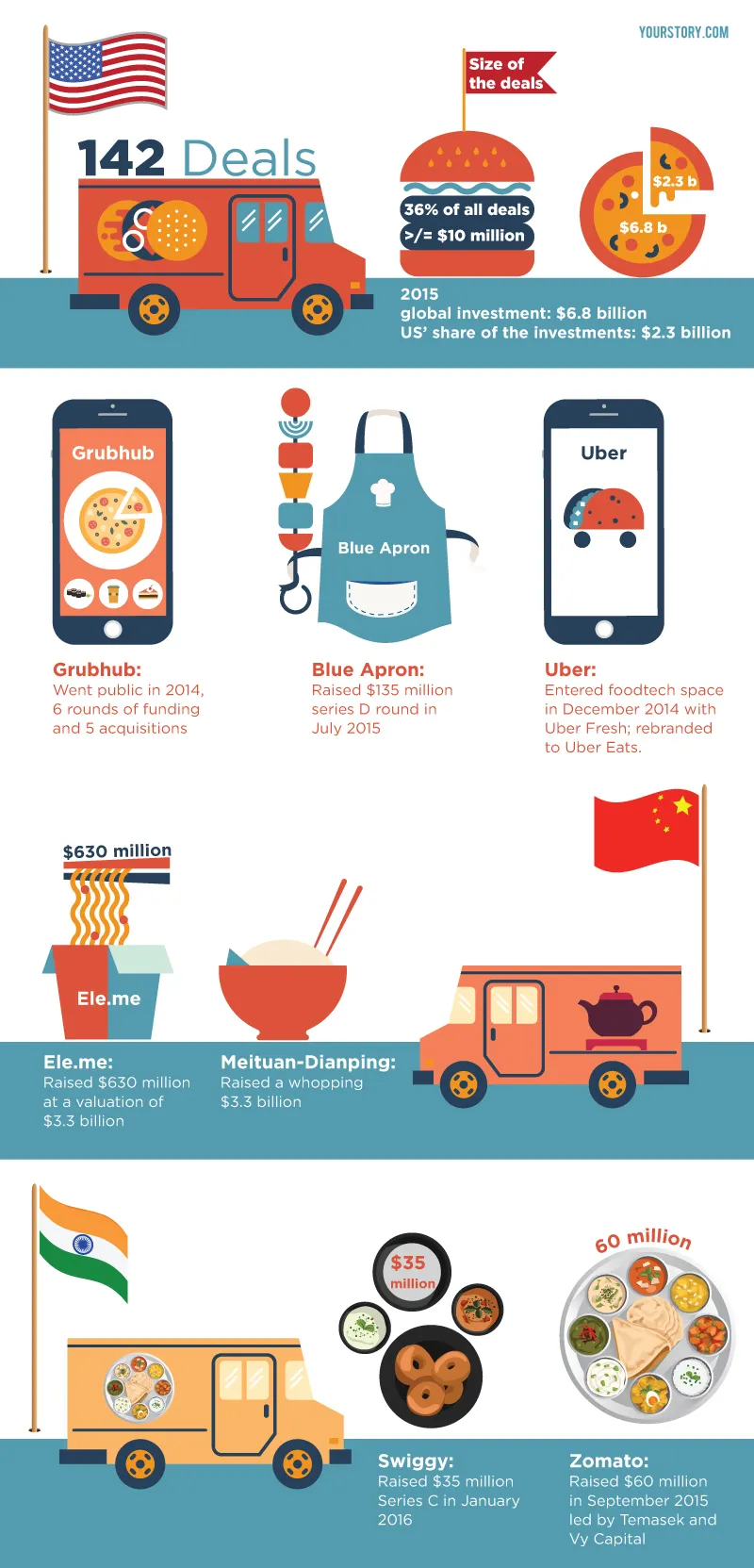Swiggy, Ele.Me or Grubhub - who will rule the roost
Foodtech and food delivery apps have been on a roller-coaster ride this past year, and continue to garner attention and investor interest. The year began with news of Series C funding for Swiggy, and funding for FreshMenu, in addition to news of other angel investments in this space. In September last year, Zomato raised a funding of $60 million. They too have ventured into the online delivery space.
While $35 million and $60 million in funds raised is considered one of the bigger investments in India, Chinese food delivery and group buying company Meituan-Dianping raised a whopping $3.3 billion. According to China e-Commerce Research Center, Meituan’s transaction volumes reached $860 million in the first six months of 2013.
US, India, and China – the Big Three
While 2014 was a good year for foodtech with a total of $2.4 billion of private capital invested in the space, the main difference from previous years was the number of deals and the maturity of the startups.

In an interview with YourStory, Kunal Walia of Khetal Advisors said that foodtech investments in India are a perfect follow-through to the recent trend of ‘habit-forming companies’ attracting significant rounds of capital.
So, why is the foodtech scenario so much bigger in China? Ben Jiang of UC-Web says that outside of just foodtech, O2O (offline-to-online) plays a big role in China. Mobile Internet, he adds, is the future of China’s Internet industry and O2O is at the centre of mobile Internet. “So you can see that the significance of O2O in the market and this includes group buying, food delivery and lots of other forms of mobile businesses,” says Ben.
In any case, when all three markets are compared, we see that the Chinese are the strongest and still growing. Many believe that the country has so many successful food delivery players because of the extent of smartphone penetration in the country. India, China and the US are driving smartphone growth worldwide, with China in the number one position, followed by the US and India.
There are three different types of players in the Chinese food space. The first is group-buying startups like Meituan/Dianping, who have their own delivery team. The second includes companies like Baidu (Baidu Waimai) and Alibaba (Koubei), e-commerce giants venturing into the space. The third type is the pure-play food delivery startup like Ele.me.
Baidu launched food delivery services in May 2014. Since then, the team claims that Baidu Takeout Delivery has shown an increasing GMV of nearly 8x from Q1 to Q4 in 2015. Baidu Takeout Delivery currently operates in more than 100 cities, and claims to be taking more than 1 million orders per day. As of Q4 2015, Baidu Takeout Delivery was leading in 63 cities based on working age demographic, according to the company’s internal analysis.
Of all the mentioned Chinese players, Ele.me leads the country’s O2O food ordering market with a 40 per cent market share, according to a report by Analysys International. Several of the larger Internet companies are also venturing into the O2O space, the biggest of them being Alibaba.
In 2013, the number of active smartphone users touched the one billion mark for the first time. China again took the lead with 436.1 million users, the US had 143.9 million users and India had 76 million.

The city syndrome
However, like in India, food delivery and ordering apps are more popular in Tier I and II cities of China as well. This is mainly because of user demographics. Ben says that young professionals are too busy to cook. Going to a restaurant with their busy schedule isn’t much of an option either, so their focus is on ordering food online.
In India too, there is a focus on the Tier I and II cities, not just with the audiences, but also in terms of investor interest. Seedfund Venture Partner and accomplished investor/mentor Sanjay Anandaram says that most technology-enabled food businesses are operations-intensive. “Most of these app-based food businesses gain initial traction in certain pockets of a city, but the same cannot be expected from all parts of the country,” he adds.
It seems foodtech will always have a market as long as hungry people crave convenience. However, the unpredictable nature of the business with no specific patterns is leading to logistical issues. High cost of delivery and the need to ensure quality and temperature of food add to the difficulties.
To ensure long-term sustainability, foodtech startups need to focus on their unit economics and have better control on both supply and demand. The future looks interesting for foodtech, and with the breakthroughs in new age technology, a day may not be too far when drones will be able to swiftly deliver food within record times.
Cutting the competition
However, the food business in China is highly competitive and cut-throat. Niklas Ostber, Founder, Delivery Hero, was quoted in TechCrunch saying that the competition in China has become anything but sane, where companies have been flooding the markets with free food to users and no commission to restaurants. He also added that the investment needed to survive in the market is steep.
In the recent past, the focus on delivery of anything has brought Ele.me and Meituan under scrutiny. The Chinese media have reported that the giants have been involved in illegal businesses by selling food from unlicensed restaurants. The scrutiny has gotten stronger after a CTV programme airing, which reported on Weibo that authorities in Beijing will investigate the different food ordering platforms.
While the situation is under scrutiny in China, India still has a very long way to go, be it in terms of market share and penetration as in China, or in terms of using technology to build food and breaking into the market as in the US.







